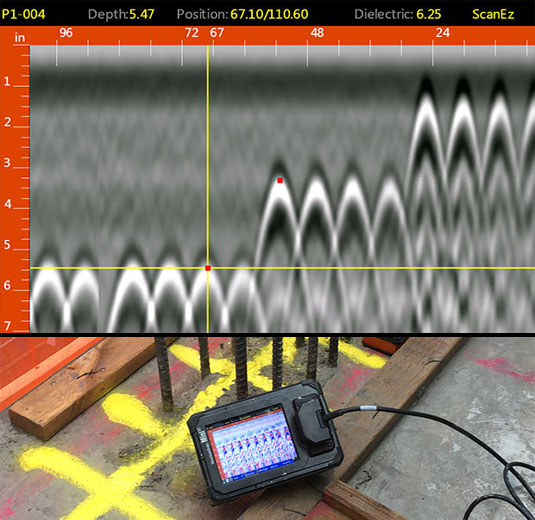Discover RainierGPR Service Areas for Reputable Concrete Scanning Solutions
Discover RainierGPR Service Areas for Reputable Concrete Scanning Solutions
Blog Article
Enhancing Job Preparation and Implementation Via Advanced Concrete Scanning Techniques
In the realm of project planning and precision, execution and insight are vital aspects that can make the distinction in between success and troubles. Advanced concrete scanning strategies have emerged as a sophisticated device set to boost the criteria of task monitoring within the building and construction market. By taking advantage of innovative innovation, these techniques supply a look into the structural integrity of a structure even before the very first brick is laid. The implications of such developments are extensive, guaranteeing a paradigm change in how tasks are approached and delivered.
Benefits of Advanced Concrete Scanning Methods

Improved Accuracy in Job Analyses
Enhancing task analyses via sophisticated concrete scanning methods considerably increases the precision and dependability of building examinations. By using cutting-edge scanning technologies such as ground-penetrating radar (GPR) and 3D imaging, project teams can now get thorough insights right into the problem of concrete frameworks, recognizing prospective problems or weaknesses that might not show up to the nude eye. This improved level of precision in task evaluations allows construction experts to make more enlightened choices concerning repair work and maintenance methods, resulting in improved total job outcomes.
In addition, the boosted accuracy in project analyses accomplished through innovative concrete scanning methods helps in decreasing the threat of unexpected issues throughout the construction stage. By proactively discovering surprise anomalies within concrete frameworks, such as rebar corrosion or gaps, job groups can deal with these concerns at an early stage, avoiding expensive delays and remodel later in the job lifecycle. Inevitably, the enhanced accuracy in task assessments promoted by sophisticated concrete scanning methods adds to higher efficiency, cost-effectiveness, and top quality in building tasks.
Early Recognition of Architectural Difficulties
Very early discovery of architectural difficulties plays an important duty in making certain the integrity and security of concrete frameworks throughout the building and construction procedure. Identifying prospective concerns at an early stage enables prompt intervention, stopping pricey rework, timetable delays, and safety dangers. Advanced concrete scanning strategies, such as ground-penetrating radar (GPR) and 3D imaging, enable project teams to discover covert flaws, gaps, reinforcement layout inconsistencies, and various other abnormalities that can compromise the find out here now framework's security.
By applying these strategies during the planning and execution stages, building and construction professionals can proactively attend to architectural challenges prior to they rise right into significant troubles. For example, detecting inadequate concrete cover over reinforcement bars beforehand can avoid rust and structural weakening in the future - RainierGPR Service Areas. Additionally, determining variations in concrete density or thickness can help maximize product use and make sure consistent strength homes throughout the structure

Inevitably, very early identification of architectural obstacles through sophisticated concrete scanning not only enhances the general quality and sturdiness of the building but additionally adds to a much safer developed setting for owners and individuals.
Boosted Precaution in Construction
The application of robust safety and security procedures is necessary in the building industry to wikipedia reference alleviate risks and secure the health of workers and stakeholders. Building and construction sites are naturally dangerous environments, with possible dangers varying from falls and tools malfunctions to structural failings. To enhance precaution, building and construction business are increasingly embracing technological advancements such as wearable gadgets that monitor employees' crucial indications and detect prospective wellness issues in real-time. In addition, the use of drones for website security enables routine safety and security examinations without putting workers in injury's way. Security training programs have actually also advanced to include online fact simulations that provide hands-on experience in handling emergency situation situations. Furthermore, the integration of expert system in safety and security management systems allows positive recognition of possible risks, enabling prompt interventions. By prioritizing safety through the unification of advanced innovations and detailed training programs, building and construction projects can considerably minimize accidents and produce a safe workplace for all included - RainierGPR Service Areas.
Streamlining Task Administration Processes
To maximize functional effectiveness and ensure job success in the building and construction industry, a focus on enhancing task administration procedures is essential. By carrying out reliable task management processes, construction jobs can minimize delays, lower expenses, and improve overall efficiency.

Verdict
Finally, the use of advanced concrete scanning strategies provides countless advantages for job preparation and execution. These methods give enhanced precision in project assessments, early recognition of structural challenges, boosted precaution in building and construction, and streamlined task monitoring procedures. Integrating these methods into task operations can eventually result in over at this website much more effective and reliable end results in construction tasks.
Ultimately, the enhanced precision in job assessments assisted in by sophisticated concrete scanning techniques contributes to greater performance, cost-effectiveness, and quality in construction jobs. RainierGPR Service Areas.
To enhance functional effectiveness and make sure job success in the building sector, an emphasis on streamlining project monitoring processes is vital. By carrying out reliable task monitoring procedures, construction projects can minimize delays, lower expenses, and enhance general efficiency. By streamlining job management processes with technology integration, clear communication, and data-driven strategies, building and construction projects can accomplish better effectiveness, cost-effectiveness, and successful end results.
These strategies give improved precision in task evaluations, very early identification of structural challenges, improved safety and security actions in building, and structured job management processes.
Report this page